Mental experiment time: Imagine you took the tile laying of Carcassonne, the worker placement of Le Havre, The pick-up-and-deliver / routebuilding of Steam, an auctioning system so odd-yet-devilishly-clever that it seems like it should’ve come straight out of a Reiner Knizia classic, a tiny bit of set collecting… player-specific hidden information… and packaged the whole bundle with over 150 wooden meeples and half a dozen cute papercraft buildings…
By rights, you should probably end up with an unplayable frankenstein mess of a game.
What you actually get is a game called Keyflower.
And it’s pretty good stuff.
MEEPLE ALL THE THINGS!
Keyflower plays up to 6 people … though on this occasion, there was only four of us: myself, Olly, Owain and Camo. At it’s core, it’s a “city builder” type game, where you’re trying to build the best settlement and score the most victory points.
Despite the vast amount of things going on in the game, the core rules are actually surprisingly simple (I hesitate to call them “elegant”, because there’s a bunch of odd edge cases and exceptions that crop up from round to round, but they’re way more straightforward than they might seem to a casual observer) …
On each turn, you can either send out some workers to make a bid on a new (building tile) addition to your village… OR, you can send out some workers to a building to do some work, and get some resources. Simple! 
The clever bit is, every player has a mixture of differently-coloured workers; red, blue, yellow and green… and once a worker has been sent to a particular tile (whether it was to bid on that tile, or to do some work), that tile is then “locked” to that specific colour for the rest of the round. Any further bidding has to be done in that colour. Any further working has to be done in that colour. …so each round is full of massively-tactical decisions to made in how you deploy your meeples; how to play to your strengths (colours that you own more of), and how to minimise your weaknesses. It’s a simple mechanism, but one that brings a *delicious* amount of depth (and some agonising descisons) to the game.
Oh, and did I mention that workers you send to another person’s village become their workers in the next round? Or that workers you send to a building that’s currently being bid upon become the property of the winning bidder? Very simple mechanisms, but — with the colour-specific bidding/working rules — they carry brain-churning implications. Brilliant stuff!
Anyway, you make bids, add tiles to your village, send your workers to work (in your own — or other players’ villages), shunt resources around the road network that you’re building to allow building upgrades / scoring opportunities, and grab new settlers, trade skills, and special bonuses off the various ships that arrive in port at the end of each season. Build a big village, improve your buildings, score points. Sorted.
For sake of variability, the game contains more tiles than you use in one single game. With a four player game, you only use around two thirds of the available tile set. In the game that we played on this occasion, we had an odd set of tiles which made transporting goods around our road networks far more difficult than it would normally be … leading to reduced scoring opportunities on buildings that depended on a certain fluidity in goods transit.
Despite this unpredicted increase in the game’s difficulty, and the fact that most people at the table were playing it for the first time (and it was only my second game), the game had a pretty good reception, and I think most people enjoyed it. Camo was even — quite seriously — mooting the idea of playing the game again immediately after we finished … despite the fact that the first game had run for 2+ hours and been a bit of a brain-burner throughout.
I did terribly badly… mostly due to my initial strategy being transport-dependent, and failing to switch to an alternative (population-boom oriented) strategy until far too late in the final round. Olly and Camo tied for victory. I really enjoyed the game; I’ll definitely take it back to the next club meeting. It’s a keeper
Ali joined our table at this point, and Camo suggested a game of…
RoboRally
RoboRally is a game in which a bored supercomputer decides to race robots around a factory floor… your objective is to be the first robot to complete the course, touching 4 checkpoints, and avoiding various hazards, deadly pits, and laser fire from your opponents.
Gameplay involved taking a hand of cards containing a list of simple orders (move forward, u-turn, turn left… etc etc…), and “programming in” a list of movements for the coming turn. Everybody then reveals their cards one-by-one, and chaos ensues. Yep, it’s basically a board-game version of robot-wars, where all the robots are powered by logo. And have big shooty lasers. (Explanatory note for anybody under the age of forty: logo is a thing we used to do with computers and turtles, back in the old days. And yes, we had to get our geeky kicks in some pretty strange ways before the internet was invented).
RoboRally is a bit of a classic game… most people with an interest in boardgaming know what it is, even if they haven’t actually played it before. Until last night, I was one such person; this was my first ever game…. but… unfortunately… I don’t think I’ll be in a huge rush to play it again.
It wasn’t a bad game, and I enjoyed it for what it was. BUT… it was just dreadfully long. I can appreciate that there’s probably a huge amount of variability, depending on how the course happens to work out, and depending on what unique brand of chaos-effect results from everybody’s starting commands conflicting with each others… and I expect I’d really enjoy this game if you could guarantee that it would be over in about an hour. But… this particular game was well past the two hour mark… actually, I suspect it might have been crawling toward the three hour point; I lost track. It certainly felt very over-long. There was also a bit of a runaway leader thing going on for the last hour or so, which was a bit demotivating — but, again, something that I imagine evolves randomly from the starting conditions.
I’m glad to have finally experienced it… but — for that degree of time investment — I would’ve sooner gone with Camo’s crazy idea to play Keyflower again
A few other games were on the verge of completion round about this point, so we opted for a quick filler to synch things up:
Tsuro
Tsuro is a very simple, very fast game. You have a coloured stone, which starts at the edge of the board. Each turn, you lay a tile next to your stone. The tile has a bunch of squiggly lines on it. You move your stone along the squiggly line until you reach it’s end. If you fall off the edge of the board, or crash into another stone: game over. The last man (or, rather, last stone) standing is the winner.
It’s basically Tron’s Light Cycles. But without the twitch skills involved. Actually, possibly without many other skills involved either, because it always strikes me as being a bit random — play the tile that allows you to strike out towards the biggest vacuum and cross your fingers. However, it’s over quickly, and fills ten minutes…
At this point, lots of other games ended, and a large group was forming to play Panic on Wall Street… I couldn’t decide whether to play or not; it seemed like it might be an interesting experience (it seats up to 11 people!), but — on the other hand — I tend not to like bartering type games, or party games, and even if it *did* end up running for the advertised “30 minutes or so” (which seemed unlikely), that probably wouldn’t leave me with long enough to play anything else of substance before it was time for me to go home. Fortunately, Owain and Ali had similar reservations, so the three of us sneaked away to play…
Myrmes
Myrmes is my other recent acquisition (along with Keyflower), and another game that got a lot of positive buzz at Essen 2012. In the game, each player controls a rival ant nest, and the object of the game is to dominate a small grassy knoll in the corner of a quiet garden.
To achieve this aim, you have an individual player board on which you run the internals of your ants nest… assigning “nurse ant” workers to hatch lavae, worker ants, and soldier ants … and you then send your ants out into the garden (depicted on the main board) to spread pheromones (claim territory), harvest resources to improve your nest, kill prey (for extra food), and achieve assorted special missions to win the favour of “The Council of Queen Ants”.
Myrmes is an unashamed eurogame. Resources are very tight, there’s an Agricola-style “feeding phase” at the end of each round which can be extremely punishing if you’re not adequately prepared, and you need to make every move count. It’s pretty unforgiving; an aspect that I had a pretty harsh schooling in on this particular outing. I made a risky move near the start of the game, sacrificing one of my nurse ants (and a heap of food) to take an early set of victory points on a (seemingly simple) mission… figuring I’d probably be able to make up for the lost food before anything too dreadful happened…. and if not, well, the short-term hit on VP couldn’t be too bad, could it?
Did my plan work? No. It didn’t. The strategy hit me *really* hard; my nest felt the consequences of this early sacrifice for many rounds afterwards, and I came in well behind in the final scoring. Moral: do not, under any circumstances, leave yourself with only two nurse ants unless you have the resources to summon up a new one very, very quickly!
But despite the fact that I was having a really, really hard time of the game, and finished way behind the other guys… I thoroughly enjoyed it. I dunno… I guess I sometimes just enjoy (semi-) succeeding in the face of overwhelming odds.
(Just as well, considering my general gaming record on this particular night!!!)
Ali and Owain really enjoyed the game too — another hit!
By this point, Saturday night had turned into Sunday morning… time to head off home! A pretty good evening’s gaming, all told. Keyflower and Myrmes were excellent (though I did appallingly badly in both of them… I’ll just chalk this up as a bad game night), and even RoboRally — while lasting twice as long as it really should have — had its high points. One of the strangest moments of the evening wasn’t actually anything to do with the game; it was the discovery/realization that one of the guys at the club (Ali) is somebody who I used to vaguely know, back in my student days… or, rather, know through mutual friends. Of course, in those days, he was Alastair. And he looked 25 years younger. And I haven’t seen him since… But it’s scary how I gradually went from not really remembering him at all, to suddenly having flashbacks of things like him teaching me how to swordfight. In a wood. In Chopwell. With a real sword.
Weird.
I was pleased that Keyflower and Myrmes got a good reception — especially since I was the guy who brought them in / had the task of teaching them. It’s always a bit of a relief when stuff that you recommend (and/or enjoy playing yourself) goes down well with others, and neither of those games are particularly simple ones to explain from a cold start, but I think I did a pretty good job. ‘Phew
Anyway, it’ll be an annoying 3-week gap until the next Newcastle Gamers… which happens to co-incide with international tabletop day. So maybe we’ll be doing something special. Who knows? I’m pretty sure I’ll have Keyflower and/or Myrmes in the bag again though
CREDITS: Session pics taken by Olly. Newcastle Gamers meets on the second and last Saturday of the month. Usual cost is £3 (or £1 for concessions), but your first visit is free … check our G+ group for more info.

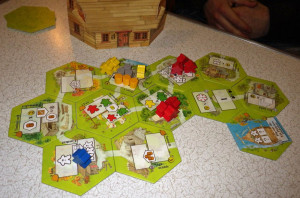
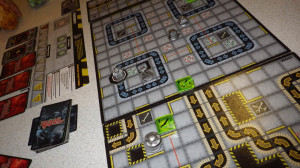

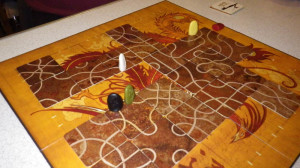
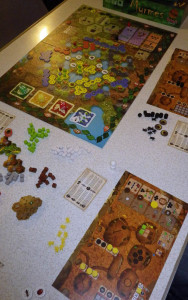
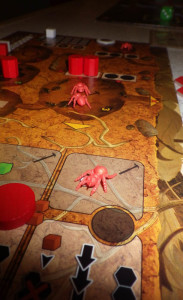
 Follow
Follow